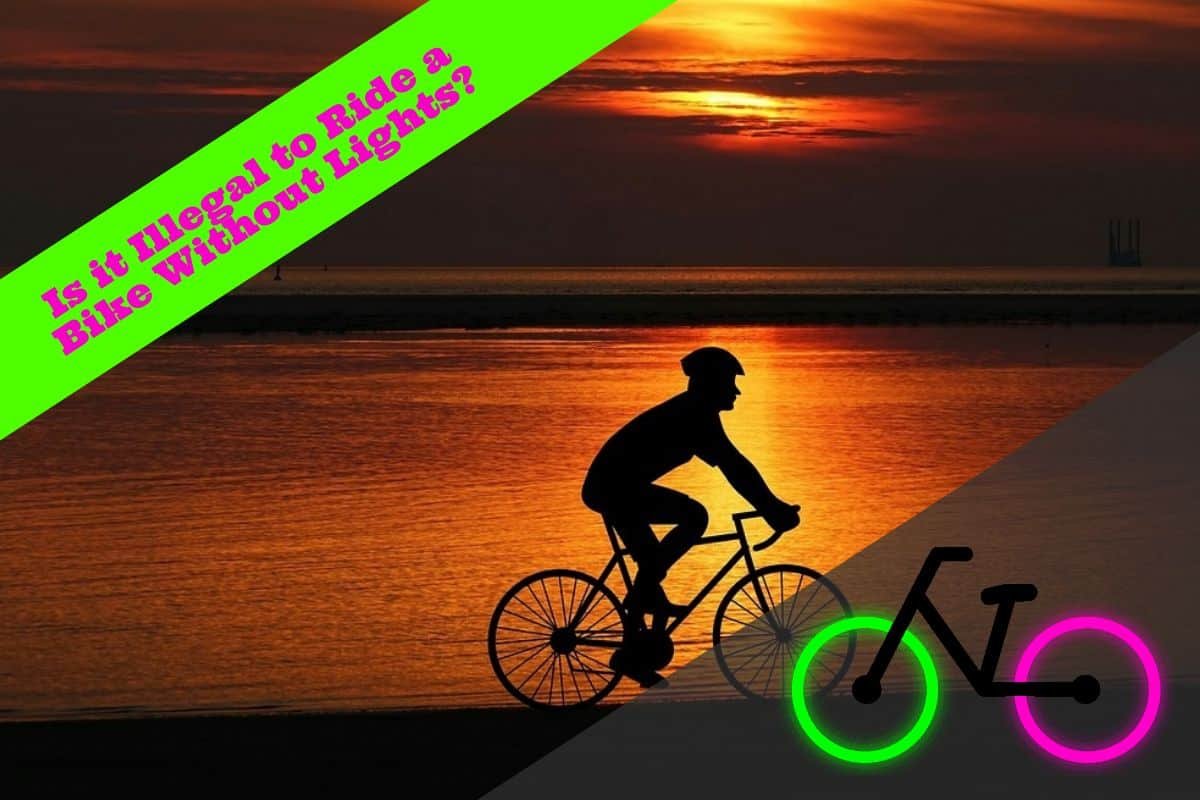Riding a bike without lights is, in all states, a traffic violation. In other words, it’s a minor offense and usually carries a relatively small fine. Lighting is required in low-light conditions, such as fog, and, in many states, from half an hour before sunset to half an hour after sunrise.

Mandatory Safety Gear
Most of us think about things like knee pads and helmets when considering safety gear for a bicycle. However, lighting is generally mandatory to have specific safety gear on the bike itself. We forget about it because it’s pre-installed on most new bikes.
We also forget that bikes are, legally, vehicles on the road with just as many obligations as drivers. You have to follow the traffic signs, and you have to have the required safety equipment. If your bike is older, you’ll probably have to buy and install at least some of it.
Your bike must have lights and reflectors in every state and in many other countries. New bikes usually come with reflectors installed because federal law requires that, but you probably have to buy and install your lights. You can also, of course, add more reflectors, but you must meet the legal minimum. To meet that minimum, you must have the following:
- Clear front reflector(s)
- Red rear reflector(s)
- Clear or amber pedal reflectors
- Clear or amber front wheel reflector(s)
- Clear or red rear wheel reflector(s)
Reflectors are often referred to as passive lighting because they light up based on being struck by other light beams rather than producing their own light. They can’t be used alone because they don’t always provide adequate visibility.
Types of Lighting
No matter what kind of lights you choose, remember that they cannot replace the required reflectors. Those reflectors are, as we said, required by federal law and must be on your bike.
Typically, a bike has to have at least one light. A standard requirement is for a white front light. It should extend its beam at least 500 to 600 feet ahead of you (state laws vary). If the light not only indicates your presence on the road, but also helps you to see, it is called a “seeing light.”
You can also add a rear light. This light is not required. If you do add one, however, it must be red and not white. These lights are intended to make you more visible to others on the road and are sometimes called “be-seen lights.”
Combo Light Reflectors
Some lights serve as reflectors and lights. If you install one of these combination lights, you do not have to have a separate reflector on the front of your bike. You will still need to have the rear and pedal reflectors.
Wearable Lights
You may want to think about wearable bike lights. They attach with a clip to some part of your body and help to increase your visibility. The most common wearable light attaches to your helmet. In addition to increasing your visibility, they also help you to see more ahead of you.
Brightness Levels
Most bike lights allow for certain adjustments. They come in different ranges of brightness (or lumens) and the highest is not always the best. Your rear light should be in the range of 20-100 lumens, with a front light between 100 to 300 lumens depending on whether you’re riding in the city or more rural, less well-lit areas. If there is very little light, such as in wooded or country areas, you should have a front light of 700 to 1000 lumens. Finally, if you’re an off-roader, 1000 lumens is your minimum.
However, getting your lights too bright can cause problems by dazzling others on the road. High-powered LED lights can be particularly difficult for them.
Steady or Flashing Beams
Flashing lights on have become popular on bike lights as an aid to visibility. Putting your light in flash mode also extends battery life. On the other hand, some drivers dislike flashing bike lights, saying they make it difficult to judge how far away the bike is. Because of this, you may want to have a light that can be steady or flashing instead of just a flashing light.
Flashing lights are not legal in every state, so be sure to check your local law before relying on flashing lights. Some states limit the vehicles that can have flashing lights. If your state does that and also considers a bike to be a vehicle, you probably can’t have flashing lights. Again, the careful thing to do is confirm your state’s rules.
What Penalties Apply?
« How To Install Bike Lights Properly
Best Bike Lights for Burning Man »
You probably know that it’s not safe to ride without lights and reflectors. But it can also be expensive. In most cases, driving without lights during the day does not carry any penalty. However, doing so at night or in other low-light conditions can result in a ticket with a fine that can be as high as $200. Some locations may require that you attend a class rather than pay a fine.
Other Impact of Inadequate Lights/Reflectors
The other significant risk of riding without lights is what will happen if you’re in an accident. Your failure to have lights will be seen as negligence on your part. Depending on your state, this could reduce your recovery in a settlement or prevent it altogether. And it’s pretty evident that if you don’t have lights, you’re more likely to be in an accident in the first place.
In Short….
So, the short answer is yes, it is illegal – and imprudent – to ride without lights on your bike. Having at least the minimum required lights will protect you from tickets, from other drivers, and from problems in an accident. Review your local legal requirements and make sure that your bike at least complies with those minimums.

